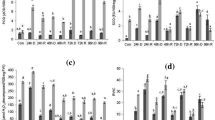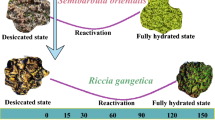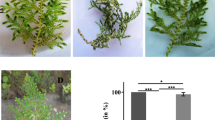Abstract
Desiccation, a major environmental stress, affects water potential and turgor in the plants leading to physiological imbalance. Though bryophytes have the ability to endure desiccation, the adverse environmental conditions may cause them to dry irreversibly. In the present study, desiccation tolerance mechanism of Brachythecium procumbens (Mitt.) A. Jaeger was analysed in terms of its antioxidative response and photosynthetic pigments. Plants of B. procumbens were subjected to desiccation stress for varying durations (24–96 h) along with control (0 h) at room temperature. Monitoring was done using antioxidant enzyme activities, photosynthetic pigments, chlorophyll stability index, as well as, relative water content. The antioxidative enzymes—superoxide dismutase and peroxidase—showed higher activity in desiccated plants as compared to control and increased significantly with duration of desiccation. However, the activity of catalase decreased during desiccation. The amount of chlorophyll increased up to 48 h of desiccation treatment as compared to control, whereas in rehydrated samples, relatively lower value was obtained. Majority of bryophytes may withstand a certain level of desiccation for at least a few days, but some are much more tolerant than that. The bryophyte system studied showed basic difference in enzyme activities and chlorophyll under different periods of desiccation. Hence, drought-tolerant genera need to be identified and propagated so that some pioneer colonizers of the ecosystem are naturally conserved.


Similar content being viewed by others
References
Alpert P (2006) Constraints of tolerance: why are desiccation-tolerant organisms so small or rare? J Exp Biol 209:1575–1584
Alpert P, Oliver MJ (2002) Drying without dying. In: Black M, Pritchard HW (eds) Desiccation and survival in plants: drying without dying. Wallingford, UK, pp 3–43
Arnon DI (1949) Copper enzyme polyphenoloxides in isolated chloroplast in Beta vulgaris. Plant Physiol 24:1–15
Ashraf M, Harris PJC (2013) Photosynthesis under stressful environment: an overview. Photosynthetica 51:163–190
Barón AF, García W, Melgarejo LM, Montenegro LC (2009) Physiological aspects of Racomitrium crispipilum Taylor A. (Jaeger) during dry season in Páramo de Chingaza, Colombia. Trop Bryol 30:1–7
Beuchamp C, Fridovich I (1971) Superoxide dismutase: improved assay and an application to acrylamide gels. Anal Biochem 44:276–287
Bewley JD (1972) The conservation of polyribosomes in the moss Tortula ruralis during total desiccation. J Exp Bot 23:692–698
Bhardwaj R, Singhal GS (1981) Effect of water-stress on photochemical activity of chloroplasts during greening of etiolated barley seedlings. Plant Cell Physiol 22:155–162
Castillo FJ (1996) Antioxidative protection in the inducible CAM plant Sedum album L. following the imposition of severe water stress and recovery. Oecologia 107:469–477
Clare DA, Rabinowitch HD, Fridovich I (1984) Superoxide dismutase and chilling injury in Chlorella ellipsoidea. Arch Biochem Biophys 231:158–163
Clarke NA, Hetschkun HM, Thomas TH (1996) Stress mechanisms in sugar beet. In: Fenwick GR, Hedley C, Richards RL, Khokhar S (eds) Agric food quality, an interdisciplinary approach. The Royal Society of Chemistry, Cambridge, pp 75–78
Conteras-Porcia L, Thomas D, Flores V, Correa JA (2011) Tolerance of oxidative stress induced by desiccation in Porphyra columbina (Bangiales, Rhodophyta). J Exp Bot 62:1815–1829
Csintalan Z, Proctor MCF, Tuba Z (1999) Chlorophyll fluorescence during drying and rehydration in the mosses Rhytidiadelphus loreus (Hedw.) Warnst., Anomodon viticulosus (Hedw.) Hook. & Tayl. and Grimmia pulvinata (Hedw.) Sm. Ann Bot 84:235–244
David W (2002) Limitation to photosynthesis in water stressed leaves: stomata vs. metabolism and the role of ATP. Ann Bot 89:871–885
de Carvalho RC (2013) Copping with extreme dehydration: a physiological, biochemical and molecular study on the aquatic bryophyte Fontinalis antipyretica. PhD thesis. Universidade de Lisboa, Lisboa
de Carvalho RC, Catalá M, da Silva JM, Branquinho C, Barreno E (2012) The impact of dehydration rate on the production and cellular location of reactive oxygen species in an aquatic moss. Ann Bot 110:1007–1016
Dhindsa RS (1987) Glutathione status and protein synthesis during drought and subsequent rehydration of Tortula ruralis. Plant Physiol 83:816–819
Dhindsa RS, Matowe W (1981) Drought tolerance in two mosses: correlated with enzymatic defence against lipid peroxidation. J Exp Bot 32:79–91
Elstner EF, Osswald W (1994) Mechanisms of oxygen activation during plant stress. Proc R Soc Edinb 102:131–154
Euler HV, Josephson K (1927) Uber katalase. I. Justus Liebigs Ann Chem 452:158–181
Fan XW, Li FM, Song L, Xiong YC, An LZ, Jia Y, Fang XW (2009) Defense strategy of old and modern spring wheat varieties during soil drying. Physiol Plant 136:310–323
Feierabend J, Engel S (1986) Photoinactivation of catalase in vitro and in leaves. Arch Biochem Biophys 251:567–576
Francini A, Galleschi L, Saviozzi F, Pinzino C, Izzo R, Sgherri C, Navari-Izzo F (2006) Enzymatic and non-enzymatic protective mechanisms in recalcitrant seeds of Araucaria bidwillii subjected to desiccation. Plant Physiol Biochem 44:556–563
Fu J, Huang B (2001) Involvement of antioxidants and lipid peroxidation in the adaptation of two cool-season grasses to localized drought stress. Environ Exp Bot 45:105–114
Gholamin R, Khayatnezhad M (2011) The effect of end season drought stress on the chlorophyll content, chlorophyll fluorescence parameters and yield in maize cultivars. Sci Res Essays 6:5351–5357
Halliwell B (1987) Oxidative damage, lipid peroxidation and antioxidant protection in chloroplasts. Chem Phys Lipids 44:3227–3340
Hendry G, Houghton JD, Brown SB (1987) The degradation of chlorophyll a biological enigma. New Phytol 107:255–302
James RA, Rivelli AR, Munns R, Von Caemmerer S (2002) Factors affecting CO2 assimilation, leaf injury and growth in salt-stressed durum wheat. Funct Plant Biol 29:1393–1403
Jiang Y, Huang B (2000) Effects of drought or heat stress alone and in combination on Kentucky bluegrass. Crop Sci 40:1358–1362
Kang HM, Chen K, Bai J, Wang G (2012) Antioxidative system’s responses in the leaves of six Caragana species during drought stress and recovery. Acta Physiol Plant 34:2145–2154
Kappen L, Valladares F (1999) Opportunistic growth and desiccation tolerance: the ecological success of poikilohydrous autotrophs. In: Pugnaire FI, Valladares F (eds) Handbook of functional plant ecology. Marcel Dekker, New York, pp 9–80
Kranner I, Grill D (1997) Desiccation and subsequent recovery of cryptogamics that are resistant to drought. Phyton 37:139–150
Kraus TE, Mckersie BD, Fletcher RA (1995) Paclobutrazole induced tolerance of wheat leaves to paraquat may involve antioxidant enzyme activity. J Plant Physiol 145:570–576
Levitt J (1980a) Responses of plants to environmental stress 1: chilling, freezing and high temperature stress. Academic Press, New York
Levitt J (1980b) Responses of plants to environmental stresses II: water, radiation, salt and other stresses. Academic Press, New York
Liu CC, Liu YG, Guo K, Fan DY, Li GG, Zheng YR, Yu LF, Yang R (2011) Effect of drought on pigments, osmotic adjustment and antioxidant enzymes in six woody plant species in karst habitats of southwestern China. Environ Exp Bot 71:174–183
Lubaina AS, Meenu Krishnan VG, Murugan K (2013) Induction of oxidative stress and antioxidative response mechanisms in Octoblepharum albidum Hedw. a bryophyte under desiccation–rehydration stress. Ind J Pl Sc 2:12–22
Luck M (1963) Peroxidase. In: Bergmeyer HV (ed) Methods of enzymic analysis. Academic Press, New York, pp 895–897
Manivannan P, Abdul Jaleel C, Sankar B, Kishorekumar A, Somasundaram R, Lakshmanan GMA, Panneerselvam R (2007) Growth, biochemical modifications and proline metabolism in Helianthus annuus L. as induced by drought stress. Colloids Surf B 59:141–149
Mayaba N, Beckett R (2003) Increased activities of superoxide dismutase and catalase are not the mechanism of desiccation tolerance induced by hardening in the moss Atrichum androgynum. J Bryol 25:281–286
Meenakumari Sain-Dass, Vimala T, Arora P (2004) Physiological parameters governing drought tolerance in maize. Indian J Plant Physiol 9:203–207
Millan-Almaraz JR, Guevara-Gonzalez RG, Romero-Troncoso R, Osornio-Rios RA, Torres-Pacheco I (2009) Advantages and disadvantages on photosynthesis measurement techniques: a review. Afr J Biotechnol 8:7340–7349
Mukherjee SP, Choudhuri MA (1983) Implication of water stress induced changes in the levels of endogenous ascorbic acid and hydrogen peroxide in Vigna seedlings. Plant Physiol 58:166–170
Noctor G, Foyer CH (1998) Ascorbate and glutathione: keeping active oxygen under control. Annu Rev Plant Physiol Plant Mol Biol 49:249–279
Oliver MJ, Bewley JD (1997) Desiccation-tolerance of plant tissues: a mechanistic overview. Hortic Rev 18:171–214
Oliver MJ, Mishler B, Quisenberry JE (1993) Comparative measures of desiccation-tolerance in the Tortula ruralis complex. I. Variation in damage control and repair. Am J Bot 80:127–136
Oliver MJ, Tuba Z, Mishler BD (2000) Evolution of desiccation tolerance in land plants. Plant Ecol 151:85–100
Oliver MJ, Velten J, Mishler BD (2005) Desiccation tolerance in bryophytes: a reflection of the primitive strategy for plant survival in dehydrating habitats? Integr Comp Biol 45:788–799
Paciolla C, Tommasi F (2003) The ascorbate system in two bryophytes: Brachythecium velutinum and Marchantia polymorpha. Biol Plant 47:387–393
Platt KA, Oliver MJ, Thomson WW (1994) Membranes and organelles of dehydrated Selaginella and Tortula retain their normal configuration and structural integrity: freeze fracture evidence. Protoplasma 178:57–65
Polle A (1997) Defense against photooxidative damage in plants. In: Scandalios JG (ed) Oxidative stress and the molecular biology of antioxidant defense. Cold Spring Harbor Laboratory Press, Cold Spring, pp 623–666
Pressel S, Ligrone R, Duckett JG (2006) Effects of de and rehydration on food-conducting cells in the moss Polytrichum formosum: a cytological study. Ann Bot 98:67–76
Proctor MCF, Smirnoff N (2000) Rapid recovery of photosystems on re-wetting desiccation tolerant mosses, chlorophyll fluorescence and inhibitor experiments. J Exp Bot 51:1695–1704
Proctor MCF, Ligrone R, Duckett JG (2007) Desiccation tolerance in the moss Polytrichum formosum: physiological and fine-structural changes during desiccation and recovery. Ann Bot 99:75–93
Ranganayakulu GS, Sudhakar C, Reddy PS (2015) Effect of water stress on proline metabolism and leaf relative water content in two high yielding genotypes of groundnut (Arachis hypogeal L.) with contrasting drought tolerance. JEBAS 3:97–103
Rensburg LV, Kruger GHJ (1994) Evaluation of components of oxidative stress metabolism for use in selection of drought tolerant cultivars of Nicotiana tabacum L. J Plant Physiol 143:730–737
Roy S, Sen CK, Hanninen O (1996) Monitoring of polycyclic aromatic hydrocarbons using moss bags: bioaccumulation and responses of antioxidant enzymes in Fontinalis antipyretica Hedw. Chemosphere 32:2305–2315
Sairam RK, Shukla DS, Saxena DC (1997) Stress induced injury and antioxidant enzymes in relation to drought tolerance in wheat genotypes. Biol Plant 40:357–364
Schöner S, Krause GH (1990) Protective systems against active oxygen species in spinach: response to cold acclimation in excess light. Planta 180:383–389
Seel WE, Hendry GAF, Atherton NR, Lee JA (1991) Radical formation and accumulation in vivo, in desiccation-tolerant and intolerant mosses. Free Radic Res Commun 15:133–141
Seel WE, Baker NR, Lee JA (1992a) Analysis of the decrease in photosynthesis on desiccation of mosses from xeric and hydric environments. Physiol Plant 86:451–458
Seel WE, Hendry GAF, Lee JA (1992b) Effects of desiccation on some activated oxygen processing enzymes and antioxidants in mosses. J Exp Bot 43:1031–1037
Sgherri CLM, Maffei M, Navari-Izzo F (2000) Antioxidative enzymes in wheat subjected to increasing water deficit and rewatering. J Plant Physiol 157:273–279
Smirnoff N (1992) The carbohydrates of bryophytes in relation to desiccation tolerance. J Bryol 17:185–191
Snedecor GW, Cochran WG (1967) Statistical methods. IBH Publishing Co/Lowa state University, Oxford/New Delhi
Stewart GR (1990) Desiccation injury, anhydrobiosis and survival. In: Jones HG, Flowers TJ, Jones MB (eds) Plants under stress: biochemistry, physiology and ecology and their application to plant improvement. Cambridge University Press, Cambridge, pp 115–130
Surendar KK, Devi DD, Ravi I, Krishnakumar S, Kumar SR, Velayudham K (2013) Water stress in banana—a review. BEPLS 2:1–18
Szalai G, Kellos T, Galiba G, Kocsy G (2009) Glutathione as an antioxidant and regulatory molecule in plants under abiotic stress conditions. J Plant Growth Regul 28:66–80
Terzi R, Kadioglu A (2006) Drought stress tolerance and the antioxidant enzyme system in Ctenanthe setosa. Acta Biol Cracov Ser Bot 48:89–96
Tuba Z, Proctor MCF, Csintalan Z (1998) Ecophysiological responses of homoiochlorophyllous and poikilochlorophyllous desiccation tolerant plants: a comparison and ecological perspective. Plant Growth Regul 24:211–217
Acknowledgements
We thank the University Grants Commission (U.G.C.), New Delhi for financial assistance. This work was supported by the University Grants Commission [F.4-2/2006(BSR)/BL/13-14/0375].
Author information
Authors and Affiliations
Corresponding author
Ethics declarations
Conflict of interest
All the authors contributed equally and declared that there are no conflicts of interest.
Additional information
Communicated by H. Peng.
Rights and permissions
About this article
Cite this article
Bansal, P., Srivastava, A. Desiccation-related responses of antioxidative enzymes and photosynthetic pigments in Brachythecium procumbens (Mitt.) A. Jaeger. Acta Physiol Plant 39, 154 (2017). https://doi.org/10.1007/s11738-017-2454-1
Received:
Revised:
Accepted:
Published:
DOI: https://doi.org/10.1007/s11738-017-2454-1




